‘We can now explore any sea on the planet’: Aboard the ‘Odón de Buen,’ the largest scientific ship in Spain
The flagship vessel of the oceanographic fleet will be able to explore the deepest and most unknown parts of the ocean, in order to advance conservation activities
On a sunny November day, in Spain’s Port of Vigo, a blue-and-white ship stands out from the rest of the large fishing boats. It’s the Odón de Buen, the largest scientific research vessel in Spain.
After climbing up the ladder and reaching its interior, the first thing that surprises you is its level of comfort. There’s a pleasant reception area, followed by a bright, two-story lounge, with a dining room, library and meeting room. On the port side, there are some comfortable light blue sofas next to a panoramic window, with thick glass through which the port and part of the estuary can be seen. It may be a scientific vessel, but it could pass for a luxury cruise ship.
The crew has been living on board for days, although the ship is docked. It’s waiting to set sail and test its brand new scientific equipment. Everything smells new. The floor is still protected with plastic, awaiting the official patronage of the ship. EL PAÍS visits the vessel before its inauguration, at the invitation of the Spanish National Research Council (CSIC), to which the Odón belongs.
On the stern, on the outside deck, Jordi Sorribas proudly contemplates the ship. He has spent more than two years working on its design and construction. A tall, gray-haired 57-year-old from Barcelona, Sorribas is a geologist by training. However, for years, he has worked as head of the CSIC’s Marine Technology Unit, which coordinates the activities of eight oceanographic vessels. In 1991, he embarked on the first Antarctic campaign of the Hespérides, a veteran ship in the world of Spanish oceanography. Since then, his life has been spent on scientific ships, both professionally and personally. He met his wife — also a geologist — on board the Hespérides the year it suffered a “total blackout” that left it rudderless and in the dark when it was sailing near the Canary Islands. “In Spain, we don’t have as many scientific vessels as France — which is an undisputed leader — but we’re not doing badly at all,” Sorribas points out.
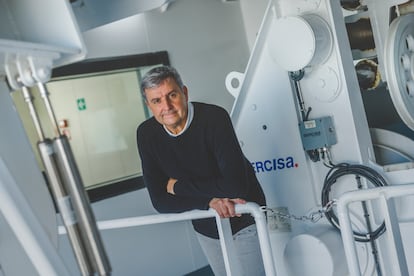
The Odón has been built to the exact specifications of the scientists. There’s no other oceanographic vessel like it. This not only means that it has the most sophisticated sonar systems or the ability to extract 82-foot-long cores from the seabed — a record — but also small comforts that you’re not aware of until you spend two months on board. For instance, there are no obstacles on the deck, which usually cause you to bump your shins when you’re loaded down with a 40-pound box of fish. There are also big cabins — with enough space for two people — that have natural light and their own bathrooms. The floors are heated and there’s a small canteen with a coffee-maker right next to the area where the fish are collected and the first sifting is done. On board, however, alcohol isn’t allowed.
On one side of the deck, there’s a kind of bright orange torpedo, more than 20-feet-long. It’s an autonomous underwater drone that can descend to 20,000 feet. The drone is equipped with various types of sonar and video cameras, which allow the scientists to observe the seabed. While Sorribas walks around the ship, his right-hand man — naval engineer Manuel Portabales — doesn’t pause for a second. He’s handling the final details that remain to be resolved before setting sail.
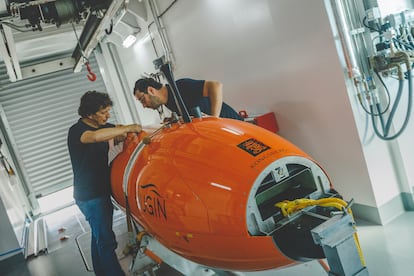
The Odón is so big — almost 280-feet-long and 60-feet-wide — that, when it was being built at the Armón Vigo shipyards, there was less than two feet of space on each side of the ship. “The number of loose pieces, all marked with their reference numbers — each of which is welded by hand, right where they have to go, in any nook and cranny — is astonishing. And their position is checked every 15 days by the certification inspector. It’s Lego in the wild,” Sorribas emphasizes. It seems astonishing that a ship like this can be built in less than two years. The Armón Vigo shipyards have long specialized in this type of work: the site is already producing new scientific vessels for New Zealand, Iceland and the Netherlands.
The main objective of the Odón is to fill the “black holes” of the oceans: those enormous areas that are still completely unexplored, according to María Gómez Ballesteros, an oceanographer and vice-president of the CSIC. “There’s an international treaty — to which Spain is a party — that aims to have 30% of all the world’s ocean floors mapped by 2030.” The remaining 70% is unknown.
The multibeam sonar that the Odón carries on its hull can reach up to 49,000 feet, deeper than the deepest known point — the Mariana Trench — which is just over 36,000 feet below sea level. The sound beams leave the ship, bounce off the bottom and return, allowing the seabed to be mapped with a resolution of mere centimetres. Until now, the CSIC scientist highlights, the resolution was several feet. This allows for a better understanding of deep ecosystems, meaning that scientists can know their state of conservation. “The benefits of this ship aren’t just for Spain or for Europe, but for the whole world. [The ship] will provide essential data, so that political decisions can then be made on how to make transportation, tourism, fishing and any other human activity in the oceans sustainable at a global level,” Gómez Ballesteros summarizes.
The Odón will be able to map the seabed at almost any point on the planet. It will also study seismic activity and cliffs on the seabed that can cause tsunamis. Thanks to its technology, it will be possible to map — in detail — the submarine canyons off the Cantabrian or Murcian coasts, as well as the seabeds in the Canary Islands, the deepest in Spain. The ship is also equipped with seismic equipment, capable of seeing what the first internal layers of the Earth’s crust are made of.
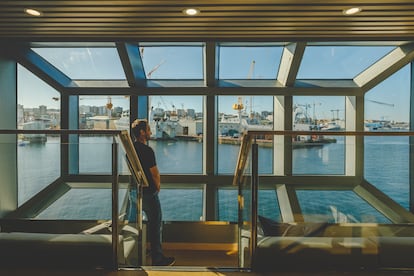

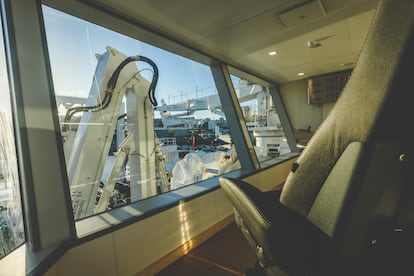
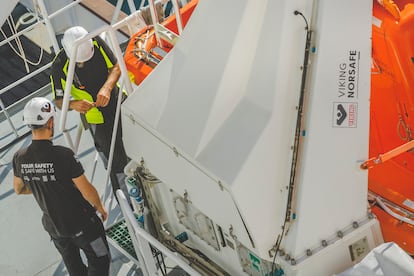
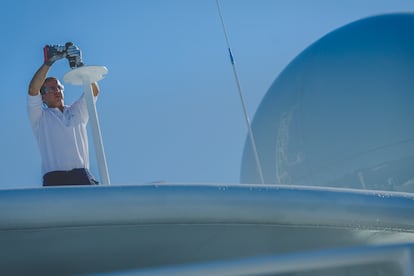

The Odón will also be the quietest ship in the scientific fleet, which is essential for studying marine fauna. “On the one hand, it was essential that — as an oceanographic research vessel — it doesn’t make noise that could harm mammals,” highlights María del Carmen García, a marine biologist and director of the Spanish Institute of Oceanography (IEO). Additionally, since the sonar — the eyes of the ship — are based on sound beams, any excessive vibration or noise could cloud its vision. “With the Odón, we can now explore any sea in the world and — thanks to its advanced laboratories — we’ll disembark with all the scientific work practically done,” García adds.
The ship can manage for 50 days at sea: 40 with diesel and 10 more with liquefied natural gas, kept in two enormous tanks located in the bowels of the ship (and kept at 180 degrees below zero). The gas allows for a reduction of more than 90% of the emission of polluting particles during maneuvers in port or in especially sensitive areas, such as Antarctic waters.
On one of the inner decks, the Odón’s chief engineer — Rubén Porto — explains to EL PAÍS that the ship has six propellers. Four of them — two at the bow and two at the stern — allow the ship to remain almost still in the middle of the sea, with a margin of error of 1.6 feet, even when there are waves. This is essential for scientific work done with underwater robots. The two main propellers have a combined power of almost 4,000 horsepower, or more than 30 utility cars.
“Getting a ship like this out of the shipyard is a privilege; there are many people who don’t have such an opportunity in their entire career,” says Porto, a 45-year-old merchant seaman, who has spent 20 years working on ships. He’s also in charge of the ship’s other machines, such as the water treatment plant — from which all the water consumed on board comes from — the sewage treatment machine and a system that irradiates the tanks with ultraviolet light to kill any living creature. This prevents the Odón from transporting invasive species.
On the bridge is Adrián Gerpe, a 38-year-old from the Spanish region of Galicia, who is the captain of the Odón. The sailor proudly shows off the ship’s dashboard, which has satellite internet and a digital navigation system. There are no physical nautical charts (a resource that military ships still use). Gerpe commands one of the ship’s two full crews — consisting of 22 people — who will take turns approximately every 45 days. Additionally, 36 scientists can travel on board.
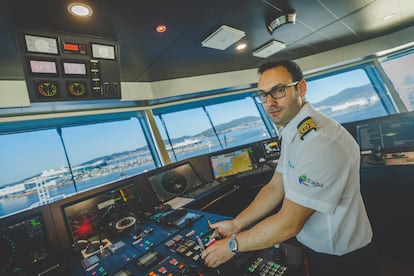
Gerpe spent a whole year working on a Russian gas tanker crossing the Arctic, breaking ice up to seven feet thick. The Odón won’t be able to do as much, but it’s capable of sailing in cold waters and breaking “young” ice, which — as Gerpe explains — is up to two feet thick.
Unlike on other types of ship, on this one, the captain is relieved of six-hour-long shifts on the bridge, so that he can supervise the rest of the maneuvers, especially the scientific ones. “As captain, I never sleep — I just rest. The first person who thinks I’m sleeping is going to be killed,” the sailor jokes.
From the bridge, two spiral staircases lead up to another facility that’s been expressly requested by the scientists: two glass turrets, from which you can see practically everything. They’ve been built to observe whales and other marine mammals.
The ship’s name is a tribute to Odón de Buen y del Cos — the father of Spanish oceanography, who founded the IEO in 1914. This progressive scientist took his first steps as an oceanographic researcher on board the Blanca, a wooden-hulled, sail- and steam-powered frigate that had survived the 1866 Battle of Callao in Peru. De Buen — who died in exile in Mexico, in 1945 — would probably be blown away by the capacities of the ship that bears his name.

The construction of the Odón has been in the works since 2008, driven by the IEO — an organization that’s now part of the CSIC, after a hasty bailout to avoid economic collapse. The ship costs $89 million, 80% of which was financed through regional development funds from the European Union for Andalusia. The other 20% comes from Spain’s Ministry of Science, Innovation and Universities. On Thursday, November 21, the official launch ceremony for the ship took place. It was carried out by Clementina de Buen, a doctor and granddaughter of the Spanish oceanographer.
After the public events, the ship is scheduled to return to the Port of Vigo, to fill its holds and prepare for its first major campaign. It will set sail in January and will reach Antarctica, where the crew and a small scientific team will test their equipment in cold waters. If they’re lucky, they’ll try to reach the Weddell Sea, which is full of icebergs. However, the ship will first have to cross the Drake Passage, which separates the tip of South America from the frozen continent. It’s probably the stormiest sea on the planet.
Sign up for our weekly newsletter to get more English-language news coverage from EL PAÍS USA Edition
Tu suscripción se está usando en otro dispositivo
¿Quieres añadir otro usuario a tu suscripción?
Si continúas leyendo en este dispositivo, no se podrá leer en el otro.
FlechaTu suscripción se está usando en otro dispositivo y solo puedes acceder a EL PAÍS desde un dispositivo a la vez.
Si quieres compartir tu cuenta, cambia tu suscripción a la modalidad Premium, así podrás añadir otro usuario. Cada uno accederá con su propia cuenta de email, lo que os permitirá personalizar vuestra experiencia en EL PAÍS.
¿Tienes una suscripción de empresa? Accede aquí para contratar más cuentas.
En el caso de no saber quién está usando tu cuenta, te recomendamos cambiar tu contraseña aquí.
Si decides continuar compartiendo tu cuenta, este mensaje se mostrará en tu dispositivo y en el de la otra persona que está usando tu cuenta de forma indefinida, afectando a tu experiencia de lectura. Puedes consultar aquí los términos y condiciones de la suscripción digital.
More information
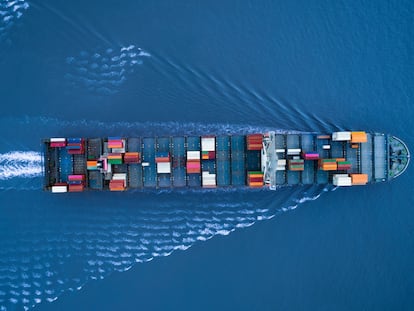
Building a Google Maps for the ocean
Archived In
Últimas noticias
Most viewed
- Reinhard Genzel, Nobel laureate in physics: ‘One-minute videos will never give you the truth’
- Oona Chaplin: ‘I told James Cameron that I was living in a treehouse and starting a permaculture project with a friend’
- Pablo Escobar’s hippos: A serious environmental problem, 40 years on
- Why we lost the habit of sleeping in two segments and how that changed our sense of time
- Chevy Chase, the beloved comedian who was a monster off camera: ‘Not everyone hated him, just the people who’ve worked with him’









































